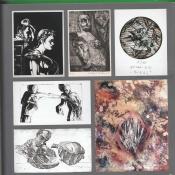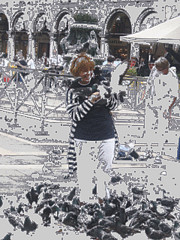The Carpatho-Danubian space bears the oldest vestiges of man’s existence and activities in Europe, indicating its belonging to the vast area of anthropogenesis.In Valcea County, at Bugiulesti, an important number of animal bones leads back to the Villafranchian period. Human osteological remains found at Ohaba Ponor Cave (two hand phalanxes and a foot one) belonging to Homo sapiens neanderthalensis speak of a different historical period.
The Cave of the Crow, once a settlement near today’s Brosteni, Gorj County, dated with radioactive carbon, proved to have been inhabited 47,550 years ago. Obviously, we cannot say much about these remote ancestors of the Carpatho-Danubian people. Yet, some of the most tragic moments in the history of the Carpatho-Danubian Space began the moment the historians-politicians tried to manipulate the past.
One feels so weak and helpless in front of these scholars who come to such aberrant, illogical conclusions about the history of the Carpatho-Danubian people, that one wonders whether one would better stay out of their “business”. Truth asks for two things: it takes someone to utter it and someone to hear it.
We shall try today to take the first step by speaking of the real ancestors of the Carpatho-Danubian Space.1. Some scholars consider that because of the similarities between Romanian and Italian and especially Latin, the Romanians are the late descendants of the Romans. Especially because the latters conquered Dacia in 106 AD ( Dacia, the old name for the Carpatho-Danubian Space nowadays inhabited by the Romanian people) for a period of 165 years.
2. Others hold that during the 165 years the Roman troops imposed Latin to the native population, to the complete disappearance of the local language. Only 14% of Dacia was conquered by the Roman soldiers who must have spoken all languages other than Latin.
How did the first theory, adopted also by the Romanian government today, begin?
1. In The Moldavian Chronicle, Grigore Ureche (1560 – 1647) traces back our ancestry to the “Ram” (Rome) because of the similarities between the language the Moldavians spoke and the one used by the population of the Italic Peninsula.What scientific arguments could he have provided 500 years ago that could support such a theory? It is hard to answer. Seemingly, leading an isolated monastic life he must have based his theory on intuition only. The harm that he did to the history of the Dacian – Romanian people has been hard to imagine.
However, what can one say about those who took over his theory only to spread it out proudly?
Miron Costin (1633 – 1691), another scholar of the Moldavian history, as if trying to overtake his predecessor, started to popularize the idea and translate it into other languages, Polish included. (See his Polish Poem). He emigrated from to when he was 18, after studying in a Jesuit college not only Polish, but also Italian and especially Classic Latin.However, they are not the only promoters of the theory supporting the Roman descent of the Moldavian, Wallachian, and Transylvanian people (who even back then shared, as they do today, the same language, very similar with Latin).
Nicolas Olahus who published his Geography of Hungary in 1558 took pride in the fact that he was of Roman lineage.Seemingly, this theory of the questionable origin and descent of the Dacian-Romanians was embraced even by Pope Pius II. (according to it, the Dacian wives and daughters were “eager” to wed and join the Roman soldiers for no other reason than to learn Latin).
The 17th century brings two other brilliant scholars, Dimitrie Cantemir and Constantin Cantacuzino, who took over and spread even farther this theory of Roman descent. (although Dimitrie Cantemir himself speaks at some point about “our Dacian language”).
The 18th and 19th century, through the movement called “The School of Ardeal” and its promoters, witness the introduction of the above theory into schools, colleges and universities.
In 1908, Nicolae Iorga, the great professor, whose mother’s maiden name was Arghiropol, during the first conference of the Popular University at Valenii de Munte, made another approach to the so-called theory of the “Romanization” of the Dacian people, a regrettable hypothesis that slowed down the Dacian research for a few hundred years.
2.However, let us see who are those who consider the Geto-Dacians the bravest among the Dacians, the true ancestors of the Carpatho-Danubians and of today’s Daco-Romanians.
In 1554, Joannes Magnus publishes in Rome his Historia de Omnibus Gothorum which speaks of the Geto-Dacians as of the founders of Europe; according to him, Zamolxis created or enacted the first written laws in the history of mankind, which would inspire the Athenian ones and almost all the legislation of the ancient world. He publishes not only Zamolxis’s laws but also the Getic alphabet. I wonder why Grigore Ureche, the Moldavian erudite scholar, did not read his book which had been written in Medieval Latin when Grigore was 6 years old. Was it his young age that stopped this well-learned Moldavian scholar from reading the above-mentioned book?
In 1597, in Lyon, the brilliant scholar Bonaventura Vulcanius publishes his De literis et lingua Getarum sive Gotharum; at the time Grigore Ureche was 37 years old, but again, unfortunately, for all his erudition, he does not seek to go beyond the knowledge he had acquired there, in a remote monastery in Moldavia.
The year 1687 bears a special significance in the history of the Carpatho-Danubian space; at Upsala, Carolus Lundius, the president of the Swedish Academy of Sciences, published his Zamolxis Primus Getarum Legislator, providing extremely well-documented information about the Geto-Dacians (unfortunately this was long after Grigore Ureche had died). However, the thesis could have been studied and further approached by Miron Costin, the Moldavian scholar, 54 years old at the time (his violent death, by decapitation, four years later followed his accusation, by the then Moldavian prince, of espionage for the Poles).
Still, documents speaking of the continuity of the Dacians on this land in the 11th century have been found within the borders of the Carpatho-Danubian Space too. Codex Rohonczi mentions that the Dacian writing went from right to left and from down upwards. This might explain why the sermon in the Orthodox Church was using Dacian, “vulgar” Latin. The first musical notes in the European history, “The Hymn of the Blachi Youth”, were the expression of these people’s loyalty towards their country and sovereign, Vlad.
In Transylvania, Nicolae Densuseanu (1846-1911), one of the greatest personalities of the Carpatho-Danubian people, finds the courage to fight the world and cast a different light on the already existing theory. The Carpatho-Danubians’ roots, according to him, do not go back to the year 106 AD; this people’s history spans back, thousands of years ago, to a time when our ancestry was synonymous with heroism.Nicolae Densuseanu’s dedication, amazing erudition and perseverance in his effort to bring to light the true historical past of his people, his pride of and love for the country inhabited by the Carpatho-Danubians and whose boundaries were only linguistically marked encouraged the scientific research, despite the opposition he faced. Proto-Latin, Pelasgian Dacia was the country he loved and sacrificed for. His Prehistoric Dacia was published posthumously, in 1913.
Years later, in 1974, in California, Los Angeles, Marija Gimbutas, the European archaeology professor, published The Goddesses and Gods of Old Europe. Sharing the same view on the above-mentioned theory, Marija Gimbutas speaks of the Carpatho-Danubian Space as of the cradle of Ancient Europe, while she calls its inhabitants the creators and founders of the European civilization, long before the Greek and Judeo-Christian civilizations flourished.There is one self-evident aspect: the Carpatho-Danubians, the oldest European people, second only to the Indians, according to Herodotus, could not have disappeared overnight, after a temporary, partial invasion (only 14% of the Dacian territory was occupied by the Roman army).The theory denying the Carpatho-Danubians’ existence before the year 106 AD is simply unacceptable, although, unfortunately, this is what the Romanian schools and universities are preaching.As unacceptable is the idea that as the Roman legions set foot on Dacia, conquering no more than 14% of its territory had, in as little time as 165 years, the entire population – both under the Roman occupation and outside it – speak a new, Romanic language (while 86% of the Dacian territory was never conquered by the Romans).
Why are the history professors in so certain that the Dacians learned Latin from the Roman army, which gathered soldiers from the four corners of the world, from Africa, Palestine, , etc.?Are they sure these Roman soldiers, coming from the most remote regions of the world, did speak Latin themselves?
What Codex Rohonczy, Joannes Magnus, Bonaventura Vulcanius, Carolus Lundius, N. Densuseanu, Marija Gimbutas, Dumitru Balasa, the priest and history researcher (see his Tale of Romanization), Ph.D. Prof. Augustin Deac (The Romanians, Geto-Dacians’ Late Nephews) defend, namely that the Dacians were speaking Vulgar Latin long before Rome itself existed, sounds by far more logical.










